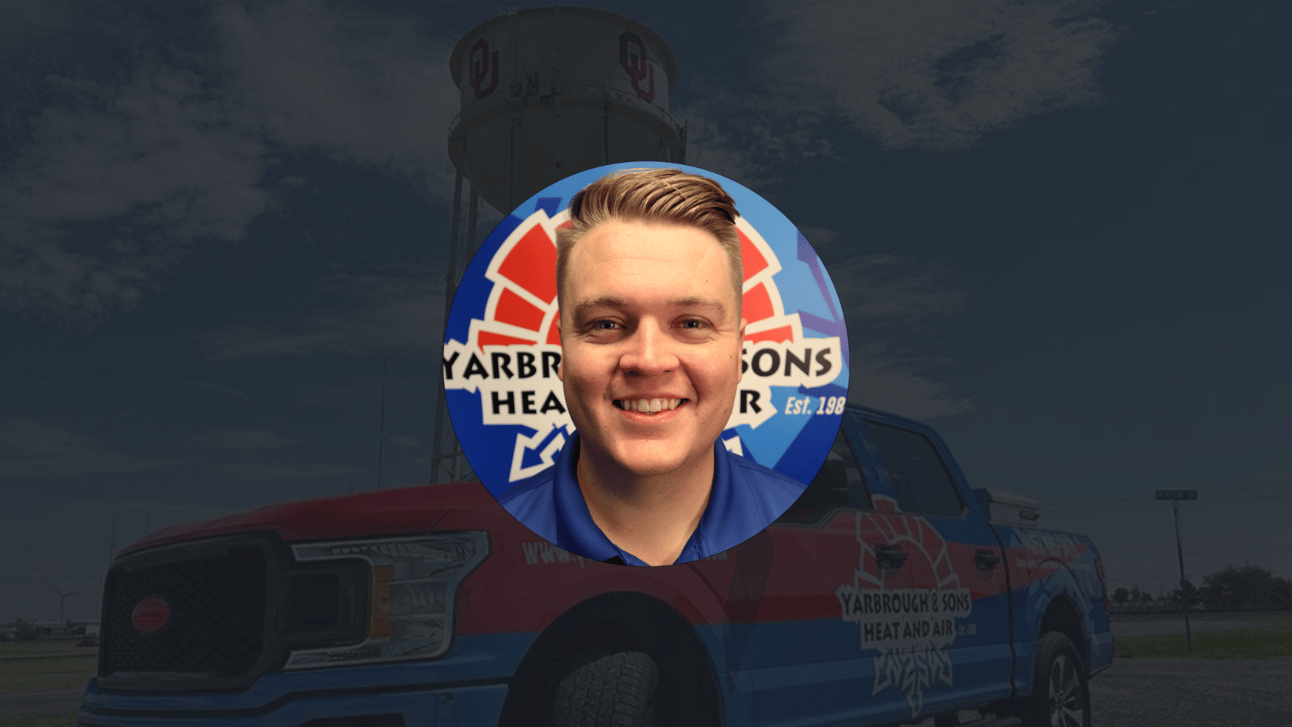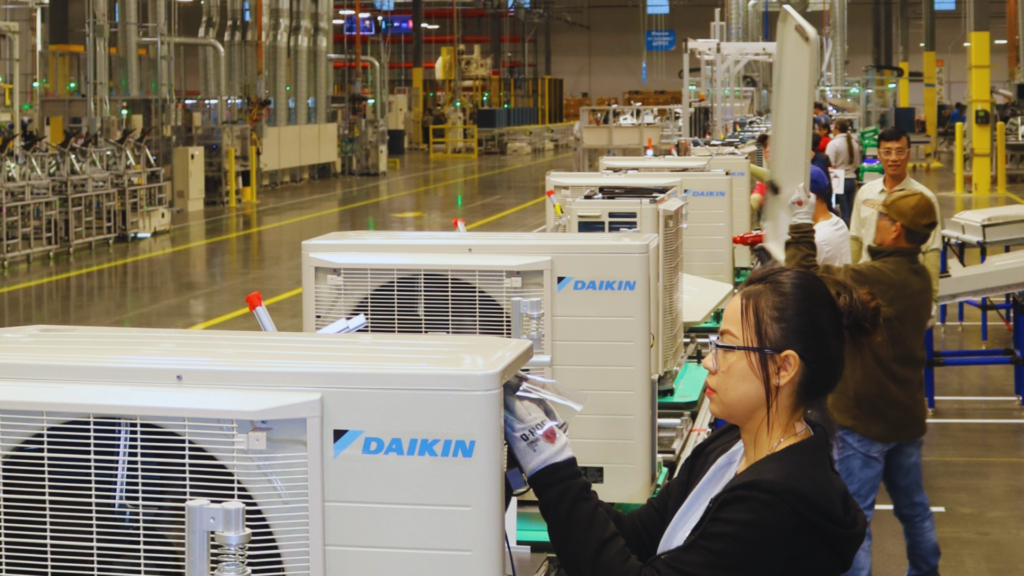Tucker Yarbrough, CFO of Yarbrough & Sons, on branding, recruiting, and financial transparency

Image: Tucker Yarbrough
❝
“If you’re slow and need work, tell your customers that. Doing that breeds a level of trust that we need in the trades.”
Tucker Yarbrough is the CFO of Yarbrough & Sons, a family-run, OK-based contracting business. We talked to Tucker about the value of branding, the relationship between advertising and recruiting, financial transparency, and more. Our conversation’s been lightly edited for brevity.
I’ve gotten a mixed bag of answers on this one before. How was last year for Yarbrough & Sons?
Last year was the largest year in our company’s history. We were down in Q1 and halfway through Q2, and then we really started focusing on branding efforts over lead-gen marketing and competing on generic search terms.
We know that our branded searches convert at a 3x higher rate than generic search terms — like “ac repair near me.” So we’re really focusing on our brand and the story behind our brand.
How’s 2024 been so far?
I’ll give you the mixed-bag answer. Residential, we’re way up — replacement’s up by about 30%, and [we’re up] about 18% on service. Commercial, however, has taken it on the chin. Our commercial is a lot of design/build stuff, and right now because of how expensive money is, we’re not seeing GCs move on larger projects.
How do you think the rest of the year will look?
We’re coming back down from the highs of “pandemic economics” and experiencing a little bit of a hangover. Single truck companies are disappearing, and it’s coming to the last bastions of privately held companies versus consolidators.
In any market, there’s a $10 to $15 million company, and then at the top, a $50 to $60 million PE-backed company. That gap is competitive, so, as independents, it’s becoming more important to play ball like the big guys.
The story of why someone should choose us [as independents] needs to be compelling, and we need to have our team dialed in. I think this year, the companies that will continue to grow are the ones focused on brand and storytelling — and not just being an HVAC company, but being a marketing company that happens to sell HVAC services.
Tactically speaking, how can contractors do branding and storytelling right?
I think the biggest thing is transparency. Transparency with your team, especially when it comes to your financials. And second, transparency with your customers. If you’re slow and need work, tell your customers that. Doing that breeds a level of trust that we need in the trades.
If a customer wants a price breakdown, our sales guys have the green light to spin the book around — we’ll walk them through our overhead. As millennials age into homeownership and decision-making, they’re gonna go with the person they trust the most, who tells them the answer first and is as clear and concise as possible.
Aside from branding, what are your major focuses for the rest of the year?
Outbounding. We paid a ton of money to acquire these customers, so how can we reach out and offer new services to them? One way we’re doing that is a courtesy hot water tank flush. When we have an HVAC maintenance tech out there, we’ll offer a free hot water tank flush. So our plumbing tech will go out, do it, and it’ll take an hour to drain. During that time, they’ll ask the customer, “Is there anything else you want me to take a look at?” More often than not, there’s something to be looked at.
As customer acquisition costs grow, largely because of private equity, we have to look for crafty ways to drive revenue. For the last ten or twelve years, the thought has been new customers, but in reality, there’s a lot of meat left on the bone with existing customers.
The second one is every Tuesday morning, we do a soft skills class with our techs. We’re quick in the industry to talk technical, but to a technician, technical is easy. The hardest part of their job is the soft skills — communicating the “Why.” So on Tuesdays, my brother Kolby runs the class, and it’s focused on how we sit down, empathize with the customer, and look at the psychological part of interactions.
❝
“Your customers aren’t dumb; they know you have to make money, they just don’t want you to make all of your money off of them.”
What are the biggest challenges ahead?
It’s been a hot topic, but staffing in the trades. There’s been encouraging data about Gen Z, but to quote Mike Rowe, in the HVAC, Plumbing, and Electrical trades, for every four people who retire, only one person is there to take their place.
One way we’re overcoming it is by adding a maintenance manager. His main KPI is not maintenance, but to graduate field-ready technicians. We’ve graduated three from that program in the last year and a half, and that’s become our way of building a bench.
We understand that we’re taking a loss on the wages for those individuals, but we’re taking baseball’s approach of building a farm team and having that bench ready to go.
Any other thoughts or insights on recruiting?
I think it’s about how well a company communicates its vision and brand to the world — those companies will have an easier time finding folks.
Every piece of marketing and advertising we put out is simultaneously doing two things. If it’s to drive customers, there’s also a piece of recruiting in there. And on the inverse, if we’re putting out a recruiting ad, it’s attracting applicants, but it’s also impacting customers.
Millennials want to do business with people they like, know, and trust more than anybody, so they want to see how we’re treating our employees.
What’s something that pisses you off in the industry?
This has come with age in the industry, but how quick we are to paint the giants in our market as an evil empire — this enemy who rips people off, screws technicians over, etc. I fell victim to that for a long time, but if you zoom out and look at their Google reviews, they have 8,000 to 10,000 five-star reviews, so there’s a dissonance that’s happening.
They’re leaving enough of a positive impact on a bunch of customers who are doing one of the highest friction things possible: Leaving a review. There’s a dissonance between what we tell ourselves in the industry and what customers are saying.
I’m not saying that all of them are great, but I’d rather look at them as someone to emulate rather than an evil empire that doesn’t do anything good. It’s not because of luck. You don’t get big by screwing people over; you get big by being good at what you do.
Do you have any counterintuitive beliefs when it comes to running the company?
It’s counter-cultural to how the industry has been, but it’s financial transparency with your customers. Your customers aren’t dumb; they know you have to make money, they just don’t want you to make all of your money off of them. It has to work for both sides. If they aren’t willing to let us make money, they aren’t our customer.
The only way we can breed trust is financial transparency at every level. Every month, we share the P&L with our team at our company breakfast. So if we’re gonna take that stance with our team, why not take it with our customers? It’s taboo, but I think with us, the proof is in the pudding through consecutive growth.
Anything else on your mind?
Anytime you’re in it, trying to grow — and we’ve been growing for three to four years — all you see is a big pile of suck. The things that we don’t do well. My encouragement is to look up to see how far you’ve come and potential opportunities on the horizon.
You won’t make more money just because you’re so star-spangled awesome. You will only ever get what you’re putting in, and just because you’re busy, doesn’t mean you’re productive. Busy is putting out fires, and that’s addicting. Being productive is finding something that needs to be worked on in the company, pulling that thread until it’s complete, and then finding the next one.
📬 Get our stories in your inbox
Keep reading
House, Senate pass competing budgets: What’s at stake for contractors
Budget proposals from both chambers of Congress tee up several decisions that could impact contractors in the months ahead
U.S. cooling demand rises 12% in 2024
The number of nationwide Cooling Degree Days jumped 12 percent compared to 2023, according to data from the National Weather Service
AC, heat pump shipments rebound in 2024
Shipments of central air conditioners and heat pumps in 2024 grew 12 percent compared to 2023, according to AHRI data


